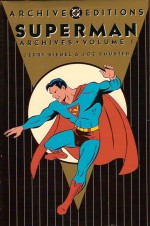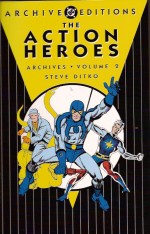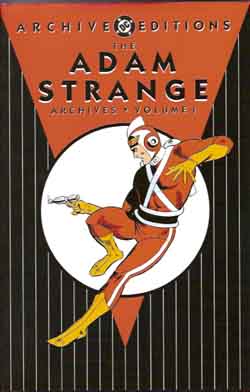
By Jerry Siegel & Joe Shuster (DC Comics)
ISBN: 978-1-56389-335-3
The creation of the Man of Steel quite literally spawned a genre if not an actual art form and, nearly eight years after the first DC Archive Edition gathered the first four issues of the comicbook Superman into a spectacular lavish hardbound collection, the company finally got around to re-presenting the epochal run of raw, vibrant, unpolished stories which preceded them – and which first set the funnybook world on fire.
Here is the crude, rough, uncontrollable wish-fulfilling, cathartic exuberance of a righteous and superior man dealing out summary justice equally to social malcontents, exploitative capitalists, thugs and ne’er-do-wells that initially captured the imagination of a generation.
In this volume you’ll meet the first ever returning foe (us old lags call ’em “arch-enemiesâ€) the Ultra Humanite plus a rip-roaring mix of hoods, masterminds, plagues, disasters, lost kids and distressed damsels – all dealt with in a direct and captivating manner by our relentlessly entertaining champion in swift and decisive fashion. Here they are presented in totality and chronological order from Action Comics #1 (June 1938) through #20 (January 1940).
Well, not exactly…
Because the first and third issues of the Man of Tomorrow’s own title featured an expanded version of the inaugural exploit and reprinted the Superman tales from Action Comics #2-5 – already seen in Superman Archives volume 1 – this tome is, perforce, not exactly a complete chronicle. However the cut-down, savagely truncated premier tale which appeared in June of 1938 to launch the long-lived anthology is here, in all its impressively terse, groundbreaking glory, as are all the Kryptonian contents of issues #7-20.
Most of these early tales were untitled, but for everyone’s convenience, have been given descriptive appellations by the editors; so after a fascinating introduction from Mark Waid, the wonderment begins with ‘Superman: Champion of the Oppressed!’ as, after describing the alien foundling’s escape from exploding Planet Krypton and astonishing powers in nine panels; the costumed crusader masquerading by day as reporter Clark Kent averted numerous tragedies by saving an innocent woman from the Electric Chair, roughing up a wife beater, busting racketeer Butch Matson – consequently saving feisty colleague Lois Lane from abduction and worse – and exposed a lobbyist for the armaments industry who was bribing Senators and fomenting war in Europe.
Although the stories themselves don’t appear, Action Comics #2-6 are represented here by a brief prose précis of each Superman yarn and the covers of the comics – all by Leo E. O’Mealia – and not one featuring the Caped Crimebuster…
The editors were initially dubious about the alien strongman’s popular appeal and preferred more traditional genre covers. By #16 sales figures confirmed that whenever the big guy did appear up-front sales jumped and, inevitably, Superman assumed pole position for decades to come with #19.
Action #7 was one of those high-selling issues, with a stunning Shuster cover of the still-leaping-not-flying hero which presaged ‘Superman Joins the Circus’ as the crusading mystery-man stopped racketeers taking over the Big Top, whilst the next episode saw ‘Superman in the Slums’ working to save young delinquents from a future life of crime and depravity and #9 featured the cops’ disastrous decision to stop the caped vigilante’s interference in ‘Wanted: Superman’. That manhunt ended in an uncomfortable stalemate…
‘Superman Goes to Prison’ in #10 again featured a Shuster cover (the non-super front images were by Fred Guardineer and are all included as an appetising bonus in this book) with the Man of Tomorrow infiltrating and exposing the brutal horrors of the State Chain Gangs, whilst #11 featured ruthless conmen driving investors to penury and suicide in ‘Superman and the “Black Gold Swindle‒.
Guardineer’s cover of Zatara on Action #12 incorporated another landmark as the Man of Steel was given a cameo badge declaring he was inside every issue, and his own adventure ‘Superman Declares War on Reckless Drivers’ was a hard-hitting tale of casual joy-riders, cost-cutting automobile manufacturers, corrupt lawmakers and dodgy car salesmen who all felt the wrath of the hero after a friend of Clark Kent was killed in a hit-&-run incident. The road-rage theme continued into the next instalment when ‘Superman vs. the Cab Protective League’ pitted the tireless force of nature against a murderous gang trying to take over the city’s taxi companies and quietly introduced the hero’s first great nemesis.
This issue also sported a classic Shuster Super-cover as the Man of Steel was awarded all the odd-numbered issues for his attention-grabbing playground.
Action #14 (which coincided with the launch of Superman #1) saw the return of the villain in ‘Superman Meets the Ultra-Humanite’ which had the mercenary scientist switch from incessant graft, corruption and murder to an obsessive campaign to destroy the Metropolis Marvel after which the cover-featured ‘Superman on the High Seas’ in #15 tackled sub-sea pirates and dry land gangsters. ‘Superman and the Numbers Racket’ saw the hero save an embezzler from suicide and disrupt another wicked gambling cabal, after which #17 featured ‘The Return of the Ultra-Humanite’ in another viciously homicidal caper.
Guardineer’s last human adventure cover – an aerial dog fight – on #18 led into ‘Superman’s Super-Campaign’ as both Kent and Superman determined to crush a merciless blackmailer, whilst ‘Superman and the Purple Plague’ found the city in the grip of a deadly epidemic created by the Ultra-Humanite.
This incredible run of tales ends with ‘Superman and the Screen Siren’ from Action Comics #20 (January 1940) as beautiful actress Delores Winters was revealed not as a sinister super-scientific monster but the latest tragic victim of the Ultra-Humanite’s greatest horror… brain transplant surgery!
Superman’s rise was meteoric and inexorable by now. He was the indisputable star of Action, plus his own dedicated title; a Superman daily newspaper strip began on 16th January 1939, with its separate Sunday strip following from November 5th of that year, which was garnering millions of new fans, and a radio show was in the offing and would launch on February 12th 1940.
Although the gaudy burlesque of monsters and super-villains still lay years ahead of our hero, these primitive captivating tales of corruption, disaster and social injustice are just as engrossing and speak powerfully of the tenor of the times. The raw intensity and sly wit still shine through in Siegel’s stories which literally defined what being a Super Hero means whilst Shuster created the basic iconography for all others to follow. These Golden Age tales are priceless enjoyment at an absurdly affordable price and in a durable, comfortingly lavish format. What dedicated comics fan could possibly resist them?
© 1938, 1939, 1940, 1997 DC Comics. All Rights Reserved.






